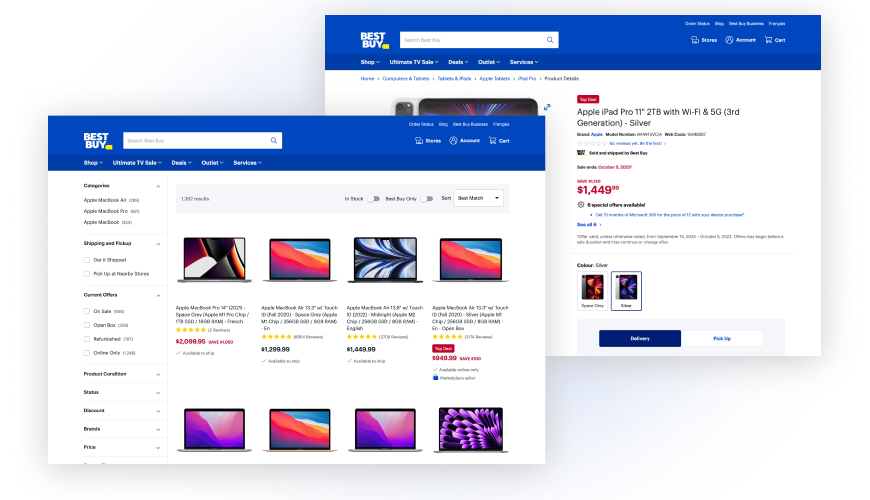
Designing a high-converting eCommerce website requires creating user-centered experiences with intuitive navigation, compelling product displays, and streamlined checkout processes. Focus on technical performance optimization, build trust through security features and clear policies, and continuously refine the site based on actual user behavior data.
Creating an eCommerce website that transforms visitors into loyal customers requires more than just attractive visuals—it demands strategic design focused on user experience and conversion principles. By implementing proven design strategies that address customer needs, simplify purchasing journeys, and build credibility, businesses can develop online stores that not only attract traffic but consistently generate sales in today's competitive online marketplace.
In this guide, we will explore 6 essential strategies that transform standard eCommerce websites into powerful conversion engines. We'll examine each proven technique in detail—from user-centered design to performance optimization—providing you with actionable insights based on our decade of experience building successful online stores for businesses across multiple industries.
6 Key Elements for Creating a High-Converting eCommerce Website
Successful eCommerce websites share six critical elements that transform browsers into buyers by addressing customer needs at every touchpoint.
1. User-Centered Design
Knowing Your Target Audience
Before designing an ecommerce website, you must understand your target audience. What are their preferences, pain points, and expectations? Tailor your design to meet their needs.
User Experience (UX) Considerations
With countless websites competing for attention, it is important to prioritize user experience (UX) considerations to ensure visitors are engaged and encouraged to return. Easy navigation is a key element of a seamless user experience. Visitors should be able to find the information they are looking for effortlessly. Clear and intuitive menus, search functionality, and well-organized content can significantly enhance the overall user experience.
Mobile Responsiveness and Accessibility
Having a mobile-responsive website when designing an ecommerce website ensures your site adapts and functions optimally on smartphones and tablets. Mobile responsiveness goes beyond just adjusting the layout of your website to fit different screen sizes. It also involves optimizing mobile users' loading speed, navigation, and overall functionality. Doing so can enhance the user experience and encourage visitors to stay longer on your site, increasing the likelihood of conversions and sales.
While understanding users forms the foundation of eCommerce success, how products are presented determines whether visitors will take the next step in their buying journey.
2. Effective Product Presentation
Presenting products effectively requires attention to three critical elements that work together to create a compelling shopping experience that drives purchase decisions.
High-Quality Product Images
When designing an ecommerce website, high-quality product visuals play a crucial role in attracting potential customers and influencing buying decisions. Compelling product images captivate and engage shoppers, ultimately increasing conversion rates.
Compelling Product Descriptions
A skillfully composed product description can be a game-changer. It's not just about listing features; it's about telling a story and appealing to the emotions of your potential customers.
Product Categorization and Navigation
Streamlined navigation and categorization are essential when designing an e-commerce website, helping users find products quickly. A well-organized product catalog enhances user experience and increases conversion potential.
With compelling product presentations in place, the focus shifts to removing obstacles from the path to purchase through a frictionless checkout experience.
3. Streamlined Checkout Process

Here are three key strategies to simplify the checkout experience and ensure a seamless path from cart to purchase. By reducing friction, offering secure payment options, and providing flexible checkout choices, you can significantly boost conversions and customer satisfaction.
Simplifying the Purchase Journey
A complicated and lengthy checkout process often results in cart abandonment. This not only leads to lost sales but also impacts the overall customer experience. To overcome this challenge, when designing an ecommerce website, it is important to simplify the path from cart to purchase. By streamlining the checkout process, online retailers can significantly increase the chances of customers completing their purchases and ultimately boost their conversion rates.
Secure Payment Options
Ensuring secure payment options is paramount for building trust with your customers and accommodating their diverse preferences. Customers need assurance that their financial information is safe when making online purchases. Offering secure payment options is a fundamental step when designing an ecommerce website in establishing trust.
Guest Checkout vs. Account Registration
Mastering the art of offering both Guest Checkout and Account Registration is a conversion secret that strikes a balance between speed and customer engagement in eCommerce design. By empowering users with choice and clarity when designing an ecommerce website, you can optimize your website for higher conversion rates and lasting customer relationships.
Converting visitors doesn't just happen on-site—it starts when potential customers find stores through search engines, making SEO optimization a critical element of any conversion strategy.
4. Optimizing for Search Engines (SEO)
A beautifully designed eCommerce website is meaningless if no one can find it. Search engine optimization (SEO) ensures your store ranks higher in search results, driving organic traffic and increasing visibility. Here are three important things you need to know about SEO to ensure your eCommerce website ranks higher in search results and attracts organic traffic.
SEO Basics for eCommerce
SEO, or search engine optimization, improves your website’s visibility on search engines like Google, helping potential customers find your products or services. Studies show that most users don’t go beyond the first page of search results—if your site isn’t ranking well, you’re missing valuable traffic and sales opportunities.
Keyword Research and Implementation
To rank higher, you need to understand what keywords your customers use when searching for products like yours. Using tools like Google Keyword Planner or Ubersuggest, you can find high-value keywords with strong search volume and low competition. Prioritizing these keywords in your content helps search engines connect your website with the right audience.
Content and Meta Tags Optimization
High-quality content keeps visitors engaged and improves rankings. Well-written product descriptions, blog posts, and landing pages help search engines understand your website and connect it with the right audience.
Optimizing meta tags like title tags and meta descriptions ensures search engines display clear, relevant information about your pages. A strong meta description encourages users to click on your site, increasing traffic and potential sales.
Mastering these SEO fundamentals strengthens your website’s visibility and drives organic traffic, leading to better conversions and long-term growth.
Even with perfect technical implementation, visitors won't convert without trust—building credibility transforms hesitant browsers into confident buyers.
5. Building Trust and Credibility
Customers won’t buy from a website they don’t trust. Reviews, security badges, and clear policies help reassure buyers, encouraging them to complete their purchases. Here are three key ways to establish credibility and build long-term customer relationships.
Customer Reviews and Testimonials
Buyers want reassurance that they are making the right choice, and customer reviews and testimonials can provide just that. By leveraging the power of customer feedback, businesses can build trust and Shoppers want proof that they’re making the right choice. Customer reviews and testimonials provide real-life insights into the quality and reliability of a product or service.
Reviews show potential buyers what others think based on firsthand experience, helping them feel more confident in their decision. Testimonials go a step further, offering curated statements from satisfied customers that highlight key benefits and success stories. Both serve as powerful trust-builders that can increase conversions.
Security and Trust Badges
With online fraud on the rise, customers are more cautious about where they enter their personal and payment information. Security badges, such as SSL certificates, signal that a website protects sensitive data by encrypting transactions.
Displaying recognized trust badges reassures customers that your website is safe, increasing their confidence in completing a purchase.
Return Policies and Customer Support
When designing an ecommerce website, you need to clearly communicate your return policy and provide exceptional support so you comply with consumer protection laws and build customer trust and loyalty, leading to increased sales and positive word-of-mouth recommendations. When shoppers know that they have the option to return a product if it doesn't meet their expectations or if they change their mind, it gives them peace of mind and encourages them to make a purchase.
Besides a well-defined return policy, excellent customer support significantly enhances your website's credibility. When customers have questions, concerns, or encounter any issues while browsing or purchasing from your website, providing prompt and helpful assistance can go a long way in building trust and loyalty.
The final piece of the conversion puzzle lies in technical performance that ensures websites can handle growth while providing a seamless shopping experience at any scale.
6. Performance and Scalability
A high-performing website keeps users engaged and drives more sales. Speed, scalability, and continuous monitoring ensure your eCommerce site can handle growth and deliver a seamless experience. Here are three key factors to keep your website running at its best.
Website Speed and Loading Times
A slow website can deter customers. Keeping up with the latest industry standards and best practices ensures that your website remains fast and user-friendly.
Scalability for Growth
Prepare your website for future growth by designing it with scalability in mind. By incorporating scalability into its structure, your website can effectively handle increasing users, content, integration and new functionality without compromising its performance or user experience.
Monitoring and Continuous Improvement
One essential aspect of website management when designing an ecommerce website is monitoring and continuous improvement. By implementing effective monitoring tools and strategies, businesses can track the performance of their websites and identify areas that require improvement. With the ever-evolving digital landscape, businesses must closely monitor their website's performance to ensure it meets users' expectations and remains competitive.
There are numerous monitoring tools available that can provide valuable insights into website performance. These tools can track metrics such as website speed, loading time, bounce rate, and user engagement. Businesses can identify potential opportunities, issues or bottlenecks hindering the website's performance by routinely analyzing these metrics.
Conclusion: Transforming Conversion Potential Into Results
Implementing these six essential strategies creates eCommerce websites that systematically convert visitors into customers. The most successful online stores balance user-centered design with compelling product presentation, streamlined purchasing processes, and technical excellence. Each element works together to create a seamless customer journey from discovery to purchase.
What distinguishes high-performing eCommerce sites isn't merely the presence of these elements, but their meticulous implementation and continuous refinement based on customer behavior and analytics. Success comes from understanding that conversion optimization is an ongoing process rather than a one-time project.
Businesses that consistently apply these principles create digital shopping experiences that not only drive immediate sales but build long-term customer relationships that generate sustainable growth and competitive advantage in the evolving eCommerce landscape.
Ready to Transform These Insights into Your E-commerce Success?
Let's implement these six proven strategies to create an e-commerce website that not only attracts visitors but converts them into loyal customers. Take advantage of a free consultation call with our team, and we'll discuss how we can implement these strategies in your ecommerce website.









